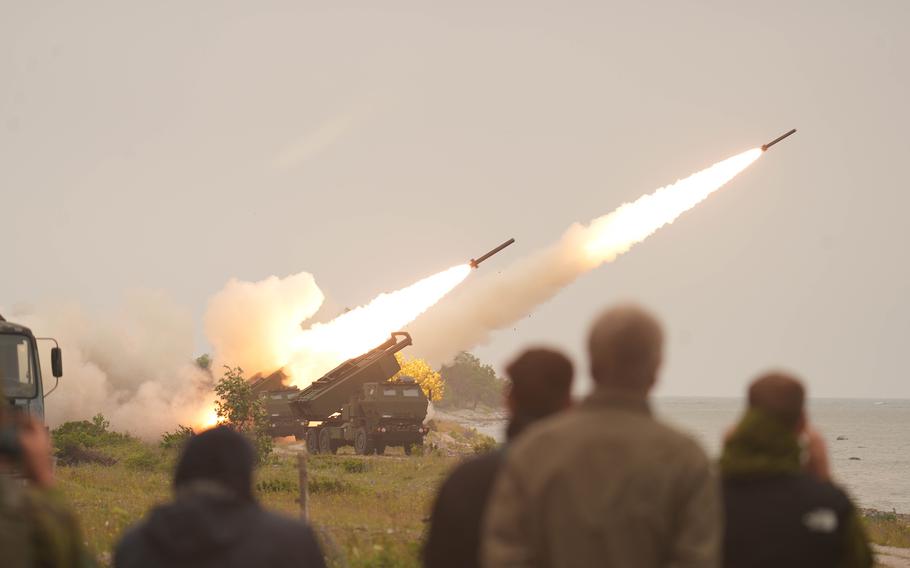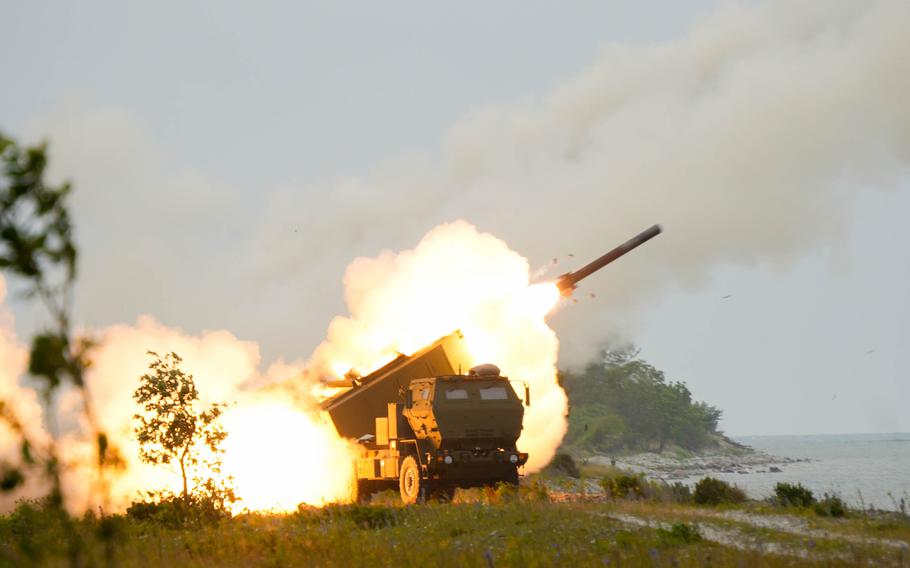
An Estonian military High Mobility Artillery Rocket System crew undertakes its first independent live fire of the precision strike weapon during an exercise at Undva, Estonia, July 11, 2025. U.S. Army personnel have been working alongside Estonian forces to train and certify HIMARS crews. (Marquis McCants/U.S. Army)
Years of joint training with U.S. soldiers on a highly sought-after precision strike weapon came to the crowning achievement for Estonia in recent days, with its forces’ inaugural launch of the High Mobility Artillery Rocket System.
Friday’s live-fire exercise on the Baltic Sea island of Saaremaa marks a milestone for Estonia and the broader region, which has worked to deepen military ties with the United States amid the Russia-Ukraine war.
A video posted on X by Estonia’s Defense Ministry shows several HIMARS launchers firing projectiles toward the sea, along with the caption “Yup, they work!”
“We’ve gone through multiple iterations of … working alongside the Estonians and getting them ready,” said Lt. Col. Andrew Underwood, chief of the Office of Defense Cooperation in Estonia. It’s the primary Defense Department liaison for bilateral defense activities
“It’s a success not just for the current unit that’s here but really going back through two years of U.S. training and engagement, making the Estonians as lethal as they could be,” Underwood said in a prerecorded interview.
The HIMARS live fire Friday capped off a weeklong exercise for the Estonians and their American trainers.

An Estonian M142 High Mobility Artillery Rocket System unleashes a training rocket during a live-fire exercise in Undva, Estonia, July 11, 2025. The exercise marked the first time Estonian troops have fired their U.S.-made HIMARS. (Rose Di Trolio/U.S. Army)
Estonia, Latvia and Lithuania — all NATO members since 2004 — fear they could be Moscow’s next target and view HIMARS’ long-range strike capability as a key tool for deterrence. Latvia and Lithuania are expected to receive their own HIMARS within a couple of years.
Estonia and the U.S. signed an agreement at the end of 2022 for the Baltic country neighboring Russia to acquire six HIMARS launchers.
In early 2023, the first element of the U.S. Army’s Task Force Voit — named after the Estonian word for “victory” — arrived to begin training Estonians to operate the systems.
The HIMARS, which gained widespread attention for its battlefield performance in Ukraine, can fire a variety of munitions, including GMLRS-guided rockets with a range of about 40 miles and M57 ATACMS ballistic missiles capable of striking targets up to 180 miles away. The launchers also are integrated easily with U.S. and allied systems.
Sgt. 1st Class Margus Oras, first sergeant of the Estonian military’s HIMARS battery, is among roughly 100 Estonian troops who have been training with Americans to prepare for operating the rocket systems.
“Today, it’s a very emotional day,” he said Friday in the same prerecorded interview, which was distributed Monday. “A big part of this emotion, it’s a thank you for American soldiers and Task Force Voit.”
The six HIMARS launchers arrived in April after being handed over to Estonian defense officials at Lockheed Martin’s production facility in Arkansas in January.
Staff Sgt. Skyler Rosekrans of the Army’s 75th Field Artillery Brigade is currently in Estonia supporting Task Force Voit, which has a dual mission: deterring aggression and training Estonians on HIMARS.
“It’s great seeing their level of excitement and how prepared they want to be and the pride they have in this kind of mission so that way they know they’re ready for whatever their country might need from them,” Rosekrans said.
The Russian government responded to the HIMARS exercise during a briefing Monday in which spokesman Dmitry Peskov alluded to “provocative actions” by countries in the Baltic region.
“Russia intends to firmly defend its legitimate interests in this region,” Peskov said, according to reporting by the Kyiv Independent.